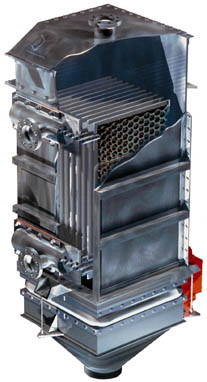The rotary drum, fluidized bed, and water-cooled screw conveyor have for many years been the standard methods used to heat or cool bulk solids in the powder and bulk-solids handling industry. The driving force behind the development of the bulk-flow heat exchanger technology was the high cost of retrofitting a fluidized-bed cooler, particularly for air-handling and wet-scrubbing systems.
The bulk-flow heat exchanger is designed for heating or cooling powder and bulk solids. This technology combines the mass flow of bulk solids with a conventional heat-exchanger design. The material mass flows through a vertical bank of hollow, stainless-steel plates. Water is circulated through the plates for cooling applications. Steam, hot water or a heat-transfer oil can be used for heating tasks. The plates have welded connections to inlet and outlet manifolds. As with conventional liquid or gas exchangers, the heat-transfer fluid and product flows are counter-current in order to improve the thermal efficiency. Below the plate bank is a mass-flow discharge device, known as a vibratory feeder, which creates a mass flow and controls the material flow rate through the exchanger.
The material moves slowly through the unit, in order to guarantee a sufficient residence time to achieve the required heating or cooling. The slow material movement ensures that there is no dust formation and no product degradation. The unit is always full of material when it is in operation, to ensure better heat-transfer control and to prevent condensation from forming. A level control system makes sure that the unit operates with its optimum configuration.
Advantages
Indirect heat exchange, which is a feature of the bulk-flow heat exchanger, offers several advantages:
• no air-handling requirements – this eliminates emissions,
• gentle product handling – no product degradation, low abrasion,
• substantial reduction in operating costs, as the only drive required is for a
water pump.
The bulk-flow heat exchanger needs no ancillary equipment such as fans, scrubbers or ductwork. The system is compact and operates by means of gravity flow, resulting in a small floor space and making it easier to install in an existing plant. The only significant utility that the bulk-flow heat exchanger requires is cooling water (for cooling) or steam (for heating). In both cases, the heat-transfer load is relatively low. In systems where cooling water is required, the existing cooling towers are usually sufficient to accommodate the extra load.
Case study
Solvay France SA was looking for the most cost-effective method of cooling polyethylene pellets prior to packaging. The product was heated up to 90 °C for drying and therefore had to be cooled down to a safe packaging temperature. The previous cooling method involved cooling the product with air in a large cylindrical drum, where its residence time was several hours. The large amounts of air that were needed and the associated emissions prompted Solvay to look for alternative technologies. The tasks that had to be performed by these technologies were:
• cooling polyethylene pellets down to 40 °C at full plant capacity,
• eliminating emissions and reducing the high power consumption associated with the use of large capacity fans.
The bulk-flow heat exchanger method of cooling was selected on the basis of the above-mentioned criteria. The cooled product was discharged via a sealed rotary valve to a pneumatic transport system, which conveyed the product to storage. The level in the inlet hopper was interlocked to a pneumatically-operated gate valve, which ensured that the unit always operated full of material and without exposing the heat-transfer panels.
The project objectives were achieved in full. The plant is able to operate at full capacity and the polyethylene pellets are cooled to better than design temperatures without generating any emissions.
Cominco
Fax: ++31/543/ 53 18 81
Further information cpp 262
Unsere Webinar-Empfehlung
Die Websession „Wasserstoff in der Chemie – Anlagen, Komponenten, Dienstleistungen“ (hier als Webcast abrufbar) zeigt technische Lösungen auf, die die Herstellung und Handhabung von Wasserstoff in der chemischen Industrie sicher machen und wirtschaftlich gestalten.
Ob effizienter…
Teilen:











